Last Friday found me at Lincoln Elementary School in Calumet City, Illinois. Lincoln is one of our STEM Institute partner schools, sending eight teachers through last summer’s Introduction to Inquiry. One of the benefits and joys of the program is the relationships we build with each of our teacher participants over the two years of the program, as we visit their classes to support their transition to the NGSS and a more inquiry-based practice.
Evangelina Sfura teaches 4th grade at Lincoln and is on Lincoln’s iTEAM. I stopped by her classroom to see the STEM Career Fair her students were putting on for each other and for students in other classes. Eva is an extraordinary teacher, and her passion for teaching, and for teaching science in particular, is contagious. I asked her if I could interview her and share her journey. Happily, she said yes.
I was fascinated to see the students engaging each other in your STEM Career Fair. They were riveted. How did that come about?
“My class participated in the event ‘Hour of Code.’ Afterwards, I was talking about STEM careers and why they are so important. One of my students raised her hand and said, ‘I know what STEM is but what kind of jobs do people have in STEM?’ That stopped me in my tracks, and I realized what a profound question that was. Students know what doctors, lawyers and teachers are, but they know nothing of engineers, analysts and programmers. How can students aspire to professions that they have never heard of?
I decided to turn that question into a project. We looked up a list of STEM careers. Student pairs were given a chance to look over the list and do some quick research to find a career they were interested in. Once they settled on a career, they used Google Slides to create a presentation. The students were especially interested in salary information, but I wanted to put that information in context so that it would have an impact. We researched 2010 US Census Data for our city to find the average salary of a person living here. We looked at the 2010 US Census Economic Data and found that the average income of a full time worker in Calumet City, Illinois, is $18,900 a year. They thought that was huge until they investigated their STEM careers. The careers the students researched had average starting salaries between $58,000 and $120,000. As one of my students told me, ‘Wow, college really is worth my time!’”
During the course of their research, many groups came across the word ‘resume’ and had no idea what it meant. That led to lessons on what a resume is and how to create one. Students used a template on Google Docs to make their own resumes which became part of their presentations. The students asked me if they could present their projects to other classes. Thus, the idea of a STEM career fair was born. The groups made posters announcing their career and other classrooms were invited. My class did an amazing job presenting their information over three days.”
Can you tell us about the Dyson connection you made, what that was like for your students, and what impact it had on them and on you?
“A colleague told me about the James Dyson Foundation and how they are promoting STEM in classrooms. Any teacher can go on their website and put themselves on a waiting list for a Dyson Ideas Box. This box contains a free month long engineering unit that allows students to explore the idea of product design. They used Dyson products as an inspiration point. My class and I were able to investigate an actual Dyson Air Multiplier to compare it to a conventional fan. This allowed my students to see that many inventions are as simple as taking an already existing product and making it more useful and efficient. By the end of the unit, students were redesigning products that are used in a classroom. My favorite was the group that decided the worst thing about a pencil is how small the eraser is. They came up with a model that had a longer, encased eraser that twisted up as the need for more arose. It was quite ingenuous!
My students loved this unit and begged me not to send the Ideas Box back. I know that it had an impact on my students. The very first lesson in the idea box had the students drawing what they thought an engineer looked like. They all drew men in suits with briefcases. The lesson was repeated at the very end of the unit. This time, without any input from me, they drew themselves, explaining that they realized they could be engineers if they wanted to!”
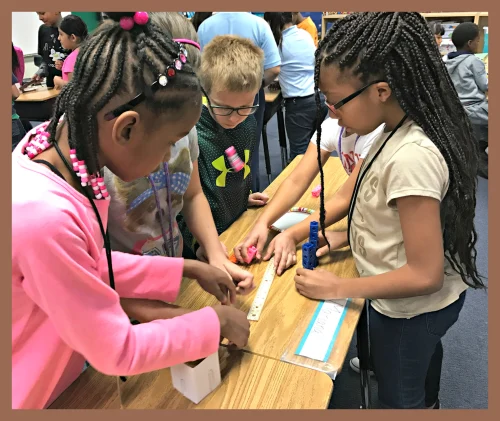
4th Graders in Ms. Sfura’s Class at Lincoln Elementary in Calumet City, Illinois, Exploring Engineering (Thank you, Dyson!)
What have you learned since completing year one of STEM Institute? Have you changed as a teacher? If so, in what ways?
“I have learned so much that I hardly know where to start. Science was my least favorite subject to teach. I really had no idea how to make it come alive the way I could do with reading or math. That is why I jumped at the chance to be part of the STEM Institute. I feel like I understand Science more than I did before. By learning to make these topics engaging for my students, I understand them better as well.
I love how the STEM Institute presents information. Instead of the usual lectures, everything is presented the way teachers should present in their own classrooms. This made me feel confidant that I could actually implement changes in my teaching immediately. My first science lesson this year involved using glow sticks to understand chemical energy! It was messy and noisy, but now at the end of the year, my students are still talking about that!
If fact, the most productive tidbit I learned is that a little chaos, noise and mess can lead to some of the most amazing conversations and explorations with my students. It is now so important to me that students get a chance to explore, investigate or research a topic before I explicitly teach it.”
What has been the most valuable take away from the program?
“One of the biggest takeaways has been to place more trust in my students. They know and can handle more than I ever gave them credit for. I am so much more comfortable letting them take the lead on investigations and projects. It is an awesome experience to sit back and watch what they are able to come up with without me guiding them step by step.
We start every topic in Science with an inquiry lesson. I often just give them the supplies and let them explore before I teach anything. By the time we get to the textbook, they already have a real world understanding of the concepts, and it makes the reading less confusing and dry. This has also changed the way the students take their science tests. I leave out any materials or equipment we used during the unit. During testing, they will often get up and repeat an experiment quickly to make sure their answer is correct! I love it!
I am using this exploration time in other subjects as well. For example, in math, I will display a problem for the students on a topic they have never seen. I have them work in groups to try to figure out the problem using what they already know. At first this scared my students. I heard a lot of whining and complaints, but I just kept reassuring them that they could figure out something and to keep trying. As they explored, they got more confident, and it was exciting to watch their enthusiasm grow. Now, they love new problems and can’t wait to tackle them. They view it as a challenge rather than a chore. My scores in math have improved dramatically as well!”
How has your thinking about STEM changed over the past year?
“I was mostly drawn to the technology aspect of STEM. I, personally, love technology and have enjoyed implementing it in my class where I am lucky to have one-to-one computing. My school has provided me with a large amount of math professional development. It was the engineering and science that I was having trouble incorporating. I will admit that I made a lot of excuses. My students were too young or too noisy. The students would act up if I tried it. They probably wouldn’t get it anyway. The truth was that I lacked the confidence to try.
Being part of the STEM Institute changed that, and not one of my excuses came to pass. My students rose higher than my expectations most of the time. Sure it was noisy, but the students were on task and excited about what they were doing. They understood what we were doing and could articulate why. I didn’t have any behavior problems during these lessons because they were so intrigued and engaged! STEM and by extension inquiry-based learning has become a large part of classroom routine. I would never revert to the way things were.”
Is there anything you want to share with other teachers who might be considering an inquiry-based approach or a more STEM-based curriculum? Any words of wisdom based on your own experience?
“My first bit of advice is to learn to be more comfortable giving up some control to your students. Set the expectation and then trust them to accomplish it. Not only will learning improve, but it has the side benefit of improving your relationship with your students. When trust is running both ways, you can accomplish more than you can imagine. I am so bonded to this class and I think it is because they feel safe, heard and trusted. They have made me so proud that on a few occassions I have teared up!
The second bit of advice would be so stop being afraid of chaos. There is such a thing a purposeful chaos. Loud is okay if students are on task and collaborating. Messy is okay if it leads to better understanding. The world will not end if students are out of their seats, exploring concepts together.”
What has been the impact on your students of your more STEM focused and inquiry-based approach? Do you see any changes in them compared with previous years’ students?
“Several times a year, I send a survey to my students asking questions about the classroom, their likes and dislikes, any changes they would like to see, etc. Every year, when I asked about their favorite subjects, science was dead last. No one really liked it. This year, however, most of the class put science first! I am really proud of that because it means the students and I both agree that changes I have made are positive ones.
I can see a change in the students themselves. They are not afraid to explore topics. In fact, they have no problem asking me if we can extend a topic or take it in a different direction than I intended. They really enjoy a challenge instead of shying away from it. I have heard conversations where my students have discussed and debated the best type of engineer to be. They discuss the best ways to code on computers and even now suggest experiments they would like to try! They are so much more involved in their learning than any group I have previously taught.
I teach many ELL students who are typically shy and do not like to speak. It has been particularly gratifying to see those students gain more self confidence. I was so proud to see all of them talking to groups during the STEM career fair as much as the students who are native English speakers!”
Eva, it is so inspiring to hear about your evolution as a teacher. I’m curious about how long you’ve been teaching and what brought you to this profession.
“I am finishing up my 11th year of teaching! I have only taught at Lincoln. Teaching is my second career. I was a marketing executive for five years before I realized that I was very unfulfilled. I was influenced by my father who had been a teacher in East Chicago, Indiana, for 42 years. We couldn’t go anywhere when I was child without running into his former students. Once we went to Atlanta, Georgia, and we still ran into a former student! All of his students adored him. He died when I was 19, and his funeral was packed with former students from all over the country. I couldn’t help thinking that he died having made a huge impact on so many people, while I was sitting in front of a computer all day. I got laid-off from my job, found a program at Roosevelt University that allowed business professionals to obtain a teaching license and never once looked back!”
What a legacy! And how proud Eva’s father would have been.
~ Penny
You can learn more about STEM Institute here.

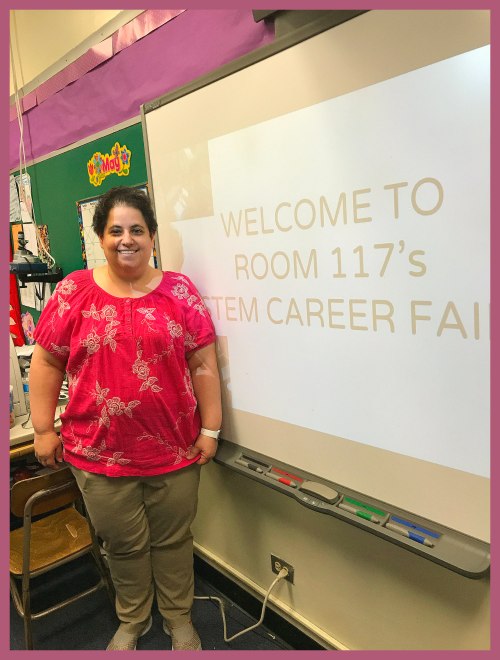
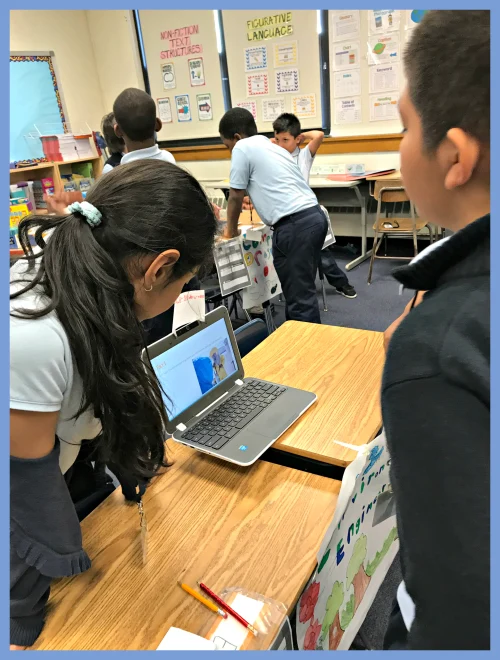
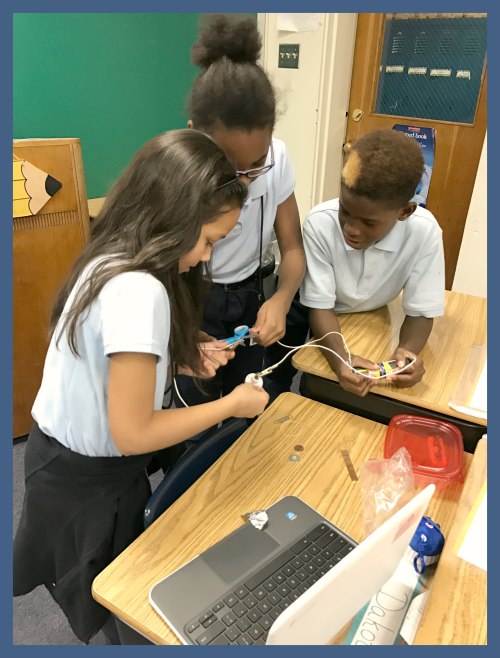
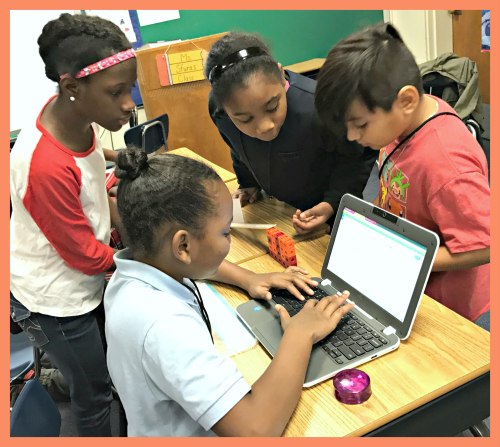
Penny –what a great article! And Eva–what an exciting place your classroom has become! Your evolution as a teacher is meteoric–I wish I could come back as one of your students!
LikeLike